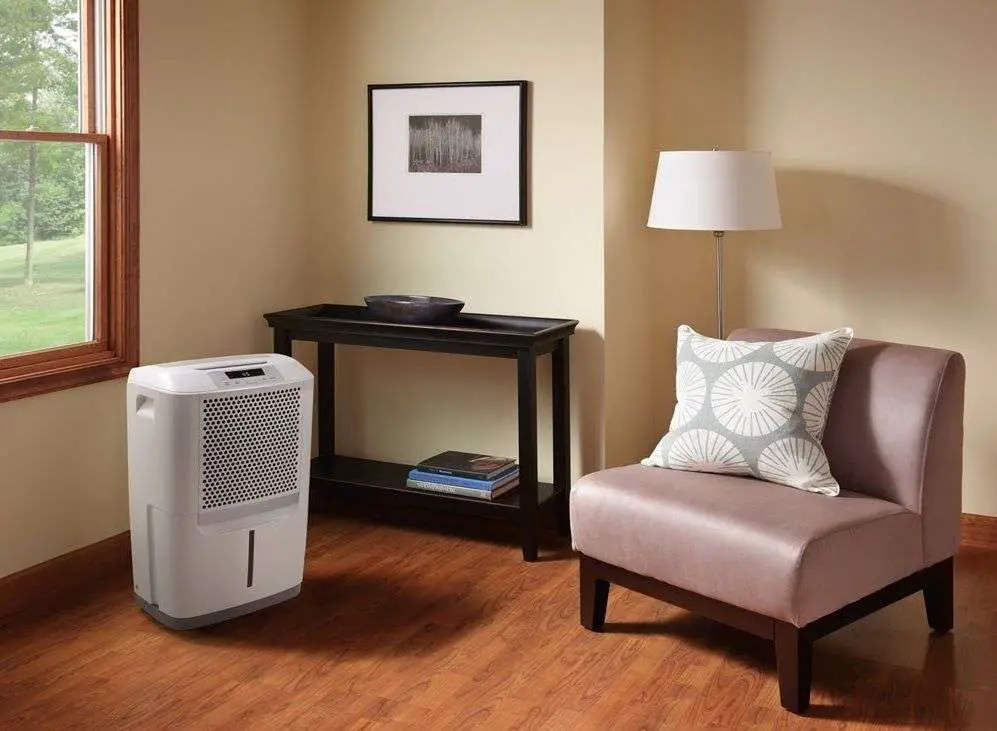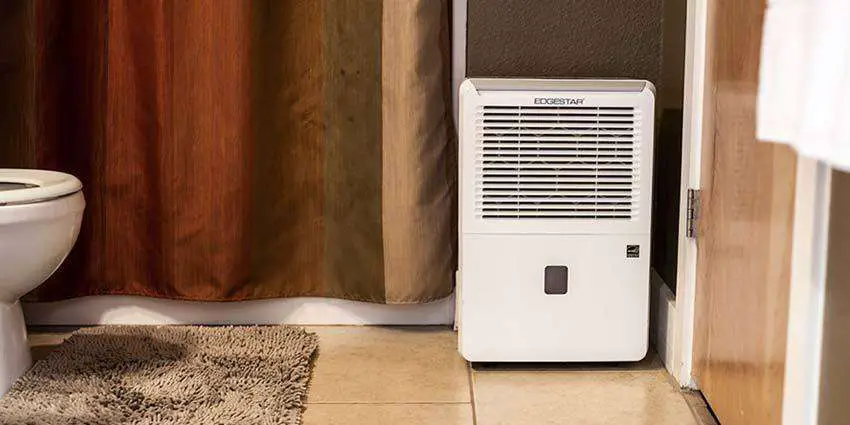The dehumidifier is one of those newfangled devices that a lot of people love to use within the home, whilst many others haven’t yet quite caught on to the benefits. And to be honest, that’s understandable – even if the clue is in the name of the device.
And so, what is a dehumidifier and why do people keep mentioning them in every other sentence when it comes to mold prevention? It’s not some kind of a mold vacuum cleaner, is it?
No, no it’s not. A dehumidifier doesn’t do much to physically remove an existing mold outbreak, other than help with dehumidifying the air while you scrub and clean. Instead, the dehumidifier prevents the growth and spread of mold by reducing the humidity levels of the home, office or any other space it’s placed in. That’s about as simple as we can put it, but it’d be perfectly fine if you still have more questions - we suggest you check out our dehumidifier reviews and buying guide.
Let’s go over some of your most common questions below.

What Is High Humidity?
Whether you live in the tropics, near a coast line, or in any other area that’s highly humid you will know how annoying higher levels of humidity can be. From causing you to sweat to undermining the wellbeing of your home and family through the prevalence of mold and mildew: high levels of humidity can be a problem.
What high levels of humidity mean is that the amount of water vapor in the air is higher than the average. The ratio of actual water vapor in the air and the amount it can actually hold is called relative humidity. Higher % levels of humidity are very favorable for the growth of mold, mildew, allergens and other such annoying and potentially dangerous problems. And as you can derive from its name, a dehumidifier works by reducing the levels of relative humidity in the air.
What Does A Dehumidifier Include In Terms Of Parts?
What do these weird machines include that help them reduce the relative humidity in any room or home? Well, different models and types have different components, but the basics are often the same:
- A grille on one side that the moist air enters through.
- An electric fan inside that draws the air through the grille.
- There are freezing cold pipes that are filled with coolant. The air passes through them and cools off, similar to how it does in an A/C unit, but not exactly the same. As the air cools down, it loses a lot of its moisture.
- Now with reduced moisture, the air proceeds through a heating element that gets it back to its original temperature (or close to).
- The warm and dry air goes out through another grille.
- The moisture that’s left inside drops into a water container inside the dehumidifier.
- An indicator monitors the level of the water in the container.
- An automatic electronic safety switch stops the machine once the container is filled with water.

What is the Desirable Humidity Level for Most Homes?
All that is well and good, but what is the actual percentage of relative humidity you want? There are more factors at play here than just the relative humidity, of course – depending on where you live, the state of the weather, the current temperature, what the temperature range is, and so on; the level of relative humidity will always fluctuate. On average, for a home in which the temperature is 68 degrees Fahrenheit, the relative humidity should ideally be between 30 and 50 percent. Anything higher than that should be addressed.
A dehumidifier used in the basement should be set to at or below the 50% RH level. This will reduce mold growth and protect the structure of your basement from damp.
How Should You Use a Dehumidifier for Optimal Mold Prevention?
This question is what makes the purchase of a dehumidifier so complicated sometimes. The short answer is that while the exact location in the room doesn’t have the greatest significance, it’s important for the dehumidifier to fit the requirements of the room. It needs to be able to operate at the temperature of the environment. It needs to be powerful enough to handle the level of relative humidity in it, without being overly powerful (or it will be a waste of money and energy). A bathroom dehumidifier for example isn't the same type you would use in a basement.
It also needs the required features for the particular environment and the type of use you need it for – it may require an option for continuous drainage of the stored water, it may need a larger container, it may need to be quiet because it’s for a bedroom, it may need more sophisticated electronic controls, and so on. But the most important thing is for the dehumidifier to have enough power to effectively and efficiently impact the relative humidity of the environment it’s in.
Once you’ve found the right dehumidifier just put it to work and it will reduce the relative humidity to a point that isn’t favorable for the growth of mold. For smaller and portable models, you may need to place them close to locations that you fear are subject to mold growth, but generally the dehumidifier will lower the overall humidity of the room it is in. This can of course be seen in the effectiveness of crawl space dehumidifiers.

What is the Difference Between a Dehumidifier and an A/C Unit? Do You Need Dehumidifier if You Already Have an A/C Unit?
A/C units and dehumidifiers are very similar in that they both pull air, they cool it off and thus reduce it humidity level and they return it to the room. The differences are that the dehumidifier reheats the air back to its original temperature as well as that it has a humidistat. Without a humidistat the A/C can’t be effectively used as a dehumidifying unit – it just regulates the temperature. With careful management an A/C unit can be used to reduce the level of relative humidity in a room, but it would do so neither effectively, nor efficiently.
Additionally, A/C units generally don’t work well in high humidity environments. As a result, adding a dehumidifier to a home with an A/C unit will not only effectively reduce the relative humidity, but it may also reduce your electricity bill by making the A/C unit more energy efficient, offsetting this against the energy the dehumidifier consumes.
Are There Different Types of Dehumidifiers? How Do the Different Models Measure up Against Mold?
As we mentioned, there are a lot of different models of dehumidifier. There are the big and stationary models that directly attach to a whole home A/C unit and work from there. There are also medium-sized or smaller portable dehumidifiers which you can simply place in whichever room, office, garage, basement or attic you choose. There are also huge portable models that can be used for entire commercial storage spaces. There are also mixed models that can work both individually and as an attachment to an A/C unit. There are even the smallest “closet” dehumidifiers which are not very powerful and are generally inexpensive but are enough for a small room like a walk-in clothes closet or other small cupboard.
As for how effective each model is in battling mold; the simple answer is that all of them are effective if they are placed in the type of room or location they were built for. It’s intuitive that a more powerful model is better than a weaker one, but it’s also unnecessarily expensive and inefficient. So, prepare well and find out exactly what dehumidifier your room, home, office or storage space needs.

Is a Dehumidifier Worth the Expense and the Electricity Bill?
This is another subjective question that highly depends on your needs. If the relative humidity level in your home is not that high then you may not need a dehumidifier badly enough to justify its cost. If the moisture is becoming a problem, however, then the right dehumidifier can definitely be worth its cost even just for mold alone. Severe mold outbreaks can be detrimental to the health of your kids and family, as well as to the structural integrity of your home. And these things are much more important and expensive to rectify than a dehumidifier.
As for the electricity bill, most good dehumidifiers are surprisingly efficient in their work, especially if they are not needlessly oversized and powerful. As we mentioned above, a dehumidifier can even reduce the electricity bill by making the job of an A/C unit easier while dehumidifying.
So, Do You Actually Need a Dehumidifier? What Else Can It Help with Other Than Mold?
Aside from mold, a dehumidifier can have a lot of other benefits for your home and family. We’ve talked about them in detail in other articles, but here are several examples:
- Reduces the amount of mildew and allergens present.
- Reduces the amount of dust in the atmosphere.
- Improves the longevity of your furniture even just by reducing the moisture in the air.
- Deals with the effects of water leaks and water run-off dampness.
- Improves your comfort by reducing annoyances like excessive sweating.
And much, much more.

Could You Benefit from Using a Dehumidifier?
Simply put, dehumidifiers are fairly simple machines that can have several positive effects on your home and your family’s life. And they can be the perfect solution for any present and future mold problems.
We suggest choosing the model most suited to your environment in terms of size and overall performance. Further information can be found in our dehumidifier resource article.

